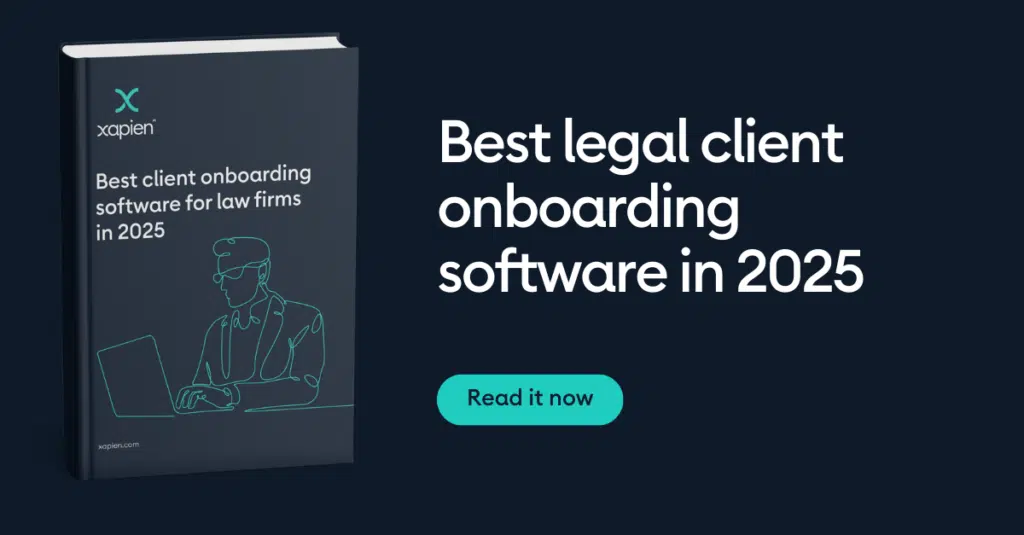
Client intake:
20 questions to ask: Law firm buyers guide to compliance tools

Onboarding new clients is where compliance teams put their knowledge into action. It’s where prevention against anti-money laundering (AML) and counter-terrorist financing (CTF) meet the real-world needs of the firm. It’s complex and time-consuming work. And to get through it, compliance teams need tools tailored to their specific requirements. While certain clients can be quickly passed through screening checks, others might require a more comprehensive investigation. This guide will help you assess the different providers and ask questions that truly matter when choosing a solution.
Firstly, what problem are you trying to solve?
Navigating the world of compliance technology can be complex, especially for smaller firms that lack dedicated technology departments. While technology can certainly simplify tasks, it’s crucial to approach it with caution. Before assuming that a tool will resolve all issues, carefully define the challenges your compliance department is facing.
Are you dealing with resource constraints, forcing you to juggle between hiring, training new staff, and conducting checks? Is the speed of compliance checks causing a backlog of client requests? Or perhaps you’re using a highly standardised process and concerned about missing important information? Take a thoughtful approach to clarify why you need this tool.
| Ask internally |
| ️ ☑️ What problems are we trying to solve with technology? |
Where does it fit into your process?
Now that you know why you need a new compliance tool, it’s time to figure out where it fits in your process. Consider whether the tool is intended to fill a gap in your process or streamline a certain aspect. Take a closer look at your compliance function’s maturity and operations. Are there manual aspects that could be automated with technology? On the flip side, are there areas where human expertise is indispensable?
Next, think about the parts of your process that might be causing inefficiencies. Perhaps reviewing false positives is holding up your compliance checks, or the manual background research required for Enhanced Due Diligence (EDD) is taking hours to complete. Likewise, too much time might be spent checking low-risk clients when you should focus your resources on high-risk clients.
Once you’ve pinpointed where you need to enhance efficiency and speed in the process, assess the technology you’re currently using. Would another tool complement the ones you’re already using, or simply add to them? Taking a close look at your process and identifying any bottlenecks will make a stronger business case for investing in a new tool.
| ️ Ask internally |
| ☑️ Where are the current obstacles or blockers in our processes? |
| ☑️ Are there manual aspects that could be automated with technology? |
What information does it collect?
With a clear understanding of why you’re introducing this tool and where it fits in your process, it’s time to consider the tool’s capabilities, guided by factors such as your firm’s size, risk appetite, typical scope of work, and your average client risk profile.
For some compliance teams, you might need a tool that manages standard screening checks like sanctions, PEPs, and watchlists for Simplified Due Diligence. Moving up to broader Customer Due Diligence (CDD) levels such as Enhanced Due Diligence (EDD), you’ll need a tool that delves deeper, including background research and adverse media screening, to ensure a more comprehensive assessment.
When dealing with high-risk clients, the demands on the tool are significantly greater. It must be capable of conducting extensive due diligence, such as analysing a client’s source of funds or their company ownership structure, as well as providing a deeper understanding of their risk profile.
| Ask internally | Ask a provider |
| ☑️ What kind of clients instruct our firm? | ☑️ Does your tool provide access to screening databases? |
| ☑️ What sort of work does our firm carry out? | ☑️ Does your tool provide access to corporate and UBO information? |
| ☑️ How risky are our firm’s activities? | ☑️ Is your tool limited to databases or does it search the wider internet? |
| ☑️ How do we check for geographic risk? | ☑️ Does your tool cover international subjects? |
How does Xapien compare?
Xapien is an AI-powered research platform that generates a comprehensive, summarised research report on any individual or organisation, worldwide. Our platform seamlessly integrates data from 0.5 billion corporate records from international corporate registries. Additionally, we access datasets from leading PEP, sanctions, and watchlist screening providers. What sets us apart is our ability to collect and process information in over 130 languages from a staggering 35 trillion web pages spanning the entire indexed internet, including blogs and news reports. This information is then neatly summarised, so compliance teams have an intuitive view of the risks and not get overwhelmed or distracted by false positives.
How does it collect information?
Once you’ve narrowed down your options based on the gathered information, it’s crucial to understand how the tool collects this data. While many compliance tools rely on industry-standard databases, it’s beneficial to consider those that go beyond datasets by searching online articles and media content. This approach allows for a more comprehensive risk assessment of a client. However, it’s important to understand how the technology works.
One of the key concerns associated with AI tools is their lack of explainability, often linked to “black box” models, where results are generated without a clear explanation. In compliance scenarios, this raises questions about reliability. When speaking with providers, make sure they can break down the process behind their technology, and give concrete examples of how it collects and processes information. This is particularly important for AI-powered tools and how the technology has been trained.
| Ask internally | Ask a provider |
| ☑️ Can we clearly articulate to each other and the regulator how this tool works? | ☑️ Can you explain how your tool collects and processes information? |
| ☑️ Have we tested this tool internally to understand the controls and whether it solves our premeditated problem? | ☑️ Will customer support be on hand to answer any questions about the tool? |
How does Xapien compare?
At Xapien, we take explainable AI seriously so our customers can fully understand how the tool works. In practice, this means publishing transparent content on our technology and working with our product team to simplify the jargon. Want to learn more about it? Read our Natural Language Processing (NLP) piece here, our disambiguation engine piece here, and how we use Large Language Models here.
Where is the information from?
To be able to use and trust the information that your compliance tool gathers it’s crucial to know not only how it collects information but also where it sources that data. That allows you to apply your judgement as to the reliability and validity of those sources. Keeping a record of sourcing is also fundamental to maintaining an audit trail for every client onboarding decision-making process.
| Ask a provider |
| ☑️ Can I read and verify the information from the original source? |
| ☑️ Can it generate reports or documentation for regulatory audits? |
How intuitive is the tool?
Now that you have a good understanding of what information the tool collects, where it obtains that information, and the quality of its sources, the next step is to evaluate how it’s presented. In other words, is the tool user-friendly enough for everyone in the department to use, or is it going to take more time to use and understand than it saves?
Functionality aside, the tool should present its results, highlighting categories of potential risks clearly and intuitively. This ensures that you can easily analyse the data, gauge the associated risk levels, and expedite your decision-making process.
With clearly presented information, you can dedicate more time to getting to know your clients based on a strong understanding of their background and business. And more importantly, being able to spot any abnormal behaviour and adjust their risk profile if needed.
| Ask a provider |
| ☑️ What sources does your tool go to? |
| ☑️ Does your technology summarise the information it collects? |
| ☑️ Is there the ability to refine or narrow down the results? |
How does Xapien compare?
Xapien extracts insights from open-source media, including roles, aliases, family, friends, wealth, source of funds, assets and more. It then compiles these details into organised tabs, eliminating the need for manually transferring data to external documents. What’s more, you can ask the report questions to surface particular information about the subject. It’s that powerful.
Chat with our experts to explore integrating AI into your compliance process and how we’ve helped other firms do it.

Monthly learnings and insights to your inbox
Xapien streamlines due diligence
Xapien's AI-powered research and due diligence tool goes faster than manual research and beyond traditional database checks. Fill in the form to the right to book in a 30 minute live demonstration.